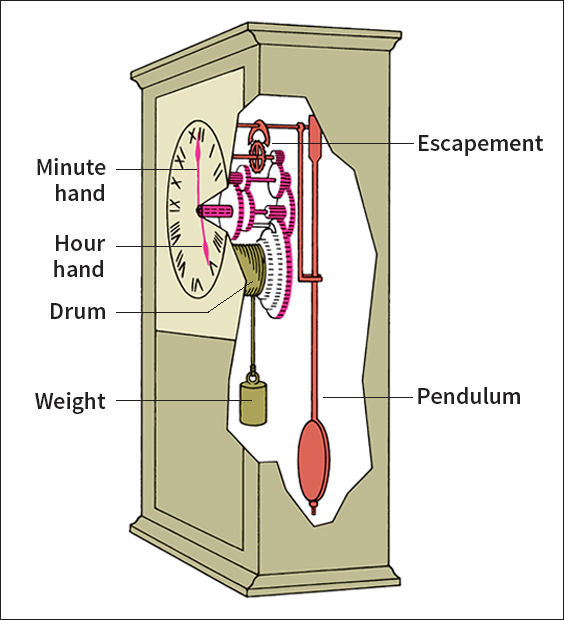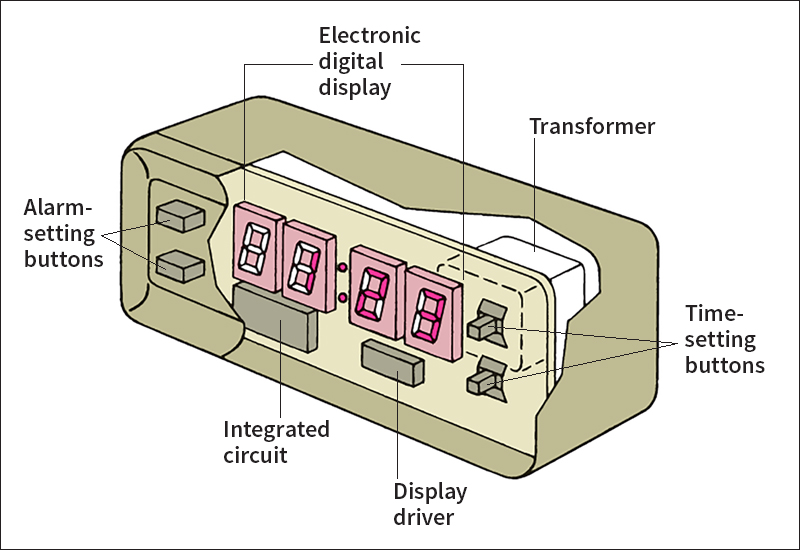Clock is an instrument that shows the time. Clocks not only measure and tell time but also serve as decorations in homes and other buildings.
The first mechanical clocks were probably developed in the late 1200’s. They had no hands or dial but told time by ringing a bell. The word clock probably comes from the French word cloche and the German word Glocke, both of which mean bell.
Kinds of clocks
Modern clocks range from small, inexpensive models to large, ornamental grandfather clocks with beautiful wood cases and complex chimes. Traditional clocks, called dial clocks, have hands that show the time by pointing to numbers on a dial. Other clocks, called digital clocks, show the time in digits on the clock face. Many clocks have chimes or sound an alarm. Others have mechanical birds or dancing figurines that mark the hours or other intervals of time.
Loading the player...Grandfather clock bells
Every clock has two main parts, the case and the works, or movement, inside the case. The works performs three functions. In addition to showing the time, it supplies power to run the clock and it keeps time. Clocks differ according to how their works carry out one or more of these three functions. This article classifies clocks into two groups, mechanical clocks and electric clocks, according to how they are powered.
Timekeeping in most clocks is based on the frequency of some regularly repeated action, such as the swing of a pendulum. Clocks with extremely stable frequencies keep time more accurately than those with less stable frequencies. For example, the operation of atomic clocks, the most accurate clocks ever made, is based on the vibrations of certain atoms and molecules. Each of these particles has a natural, characteristic frequency that is extremely stable. As a result, the best atomic clocks would not lose or gain more than a second in tens of millions of years.
Loading the player...Cuckoo clock
Mechanical clocks
are powered by various mechanical devices that must be wound at various intervals. Some have to be wound every day, but others can run for seven or eight days without rewinding. There are two main kinds of mechanical clocks, weight driven and spring driven. Almost all of them are dial clocks.
Weight-driven clocks
are powered by a heavy weight that hangs from a cord or chain. When the clock is wound, the cord or chain gets wrapped around a drum and draws the weight up near the drum. As gravity pulls the weight down, the cord or chain slowly unwinds and turns the drum. This action of the drum turns a number of gear wheels that are connected in a series called the train. The hands of the clock are attached to individual wheels in the train. Each of these wheels turns at a specific speed. A pendulum and a mechanism called the escapement prevent the weight from being lowered too fast. The pendulum and the escapement also regulate the clock’s speed.

The escapement includes an escape wheel and a verge. The escape wheel is connected to the train and turns when the clock runs. The pendulum, which is the timekeeping device of the clock, swings from side to side at a steady rate. As the pendulum swings, it tilts the verge from side to side. With each tilt, two hooks called pallets–one at each end of the verge–catch on the escape wheel and stop it. When the pendulum swings back, the pallets release the wheel, and the wheel turns slightly. This process regulates the speed of the escape wheel and of the wheels in the train. It also causes the tick-tock sound of the clock.
Spring-driven clocks
contain a coiled spring called the mainspring. This spring gets wound up when the clock is wound. Then the mainspring unwinds slowly, turning the wheels in the train.
The escapement in a spring-driven clock resembles that of a weight-driven clock. However, many spring-driven clocks have a balance wheel instead of a pendulum as the timekeeping device. A coiled spring called the balance spring, or hairspring, is connected to the balance wheel. This spring coils and uncoils and makes the balance wheel swing back and forth at a fixed rate. The swinging motion causes the verge to tilt. The pallets alternately catch and release the escape wheel and regulate the speed of the train.
Electric clocks
can be battery powered or line powered. A line-powered clock receives power from an electric outlet. Almost all digital clocks manufactured since the 1930’s have been electric models.
Battery-powered clocks.
Many battery-powered clocks have a balance wheel or a pendulum that regulates their speed. Others have a miniature tuning fork or a tiny bar of quartz crystal. The battery activates the tuning fork or crystal, which vibrates with high, steady frequencies. In clocks with a tuning fork, an indexing mechanism changes the number of vibrations into the correct speeds for the gear wheels. Quartz-based clocks contain a complex electric circuit that translates the number of vibrations into time information. The circuit also controls the time display. Most quartz-based clocks are accurate to within 60 seconds a year.
Line-powered clocks.
In line-powered clocks, the current from the electric outlet not only supplies power but also regulates the clock’s speed. The outlet supplies alternating current (current that reverses its direction). Current supplied in most parts of the United States and Canada reverses its direction 120 times every second. In some clocks, a motor counts the changes in direction and uses that information to control the time display. In other clocks, this function is performed by a computer chip, a complex electronic circuit built into a tiny piece of silicon. See Computer chip ; Electric current (Direct and alternating current) .

Most digital clocks are line powered. In some, the digits are printed on flip cards, rotating drums, or a moving tape. Other line-powered models and some quartz-based clocks have electronic digital displays, such as a liquid crystal display (LCD) and a light-emitting diode display (LED). A liquid crystal display uses digits that reflect the light around it. A light-emitting diode display has digits shaped from electronic devices called diodes, which give off light.
History
Prehistoric peoples probably told the time of day by watching shadows cast by the sun. As the sun moved, the lengths of the shadows changed. When the shadows were short, the watchers knew the time of day was near noon. When the shadows were long, they knew the day was either beginning or ending.
Sundials, which were developed more than 4,000 years ago, are among the oldest known instruments designed for telling time. As the sun crosses the sky, it casts a shadow on the dial. A sundial tells time by measuring the length or the angle of the shadow. See Sundial .
Other early timekeeping devices included hourglasses and water clocks. In these devices, sand or water flowed from one container into another at a steady rate. By measuring the material in either container, people could tell how much time had passed. See Hourglass ; Water clock .
Complicated water clocks that involved various degrees of mechanization were probably invented in China in the late 1000’s. However, these inventions were never developed further, and later Chinese clocks were based on European models.
The first mechanical clocks in Western civilization were developed by a number of inventors, probably during the late 1200’s. These clocks were weight driven, but they had no pendulum or hands. A bell rang to indicate the hour. By the mid-1300’s, the dial and hour hand had been added. The first spring-driven clocks were probably developed in Italy during the late 1400’s.
Most early clocks ran unevenly and inaccurately. The pendulum and the balance spring, which were developed during the mid-1600’s, greatly improved timekeeping accuracy. Minute and second hands became common. By the mid-1700’s, inventors had developed most of the mechanisms found in modern mechanical clocks.
Electric clocks, introduced in the mid-1800’s, were in many homes by the 1920’s. Quartz-based clocks were developed in the late 1920’s, and scientists developed the first atomic clocks in the late 1940’s and the 1950’s. Digital clocks became popular in the 1970’s, particularly as wrist watches. In the 1980’s, the computer chip was incorporated into clock mechanisms. Besides displaying the time, watches with chips can store information, and serve as calculators and miniature game boards.
